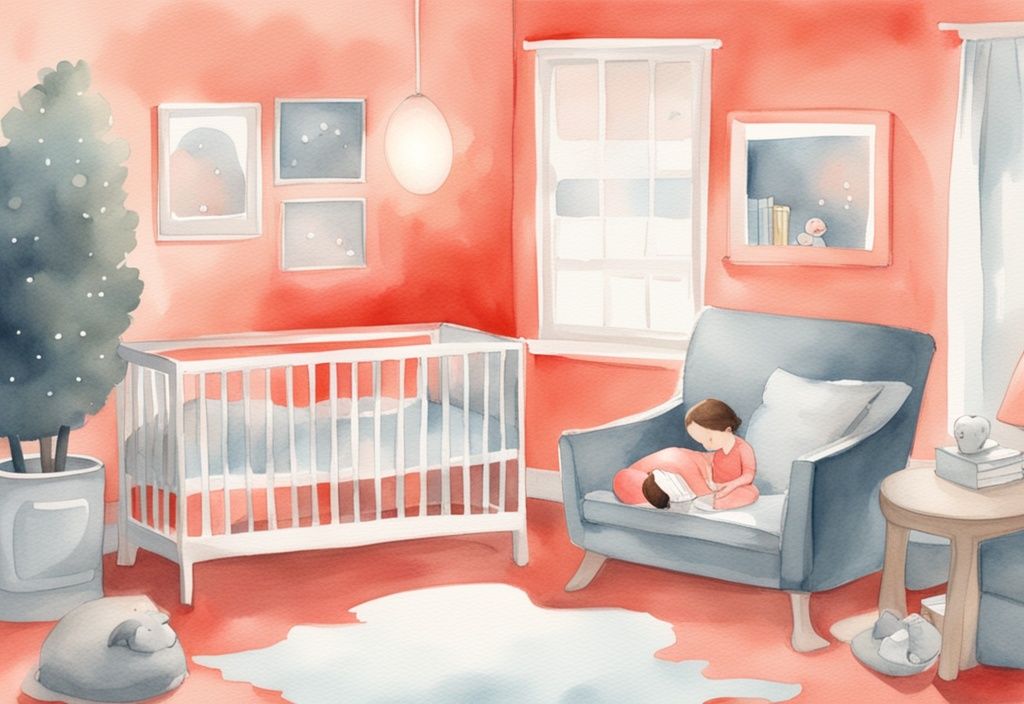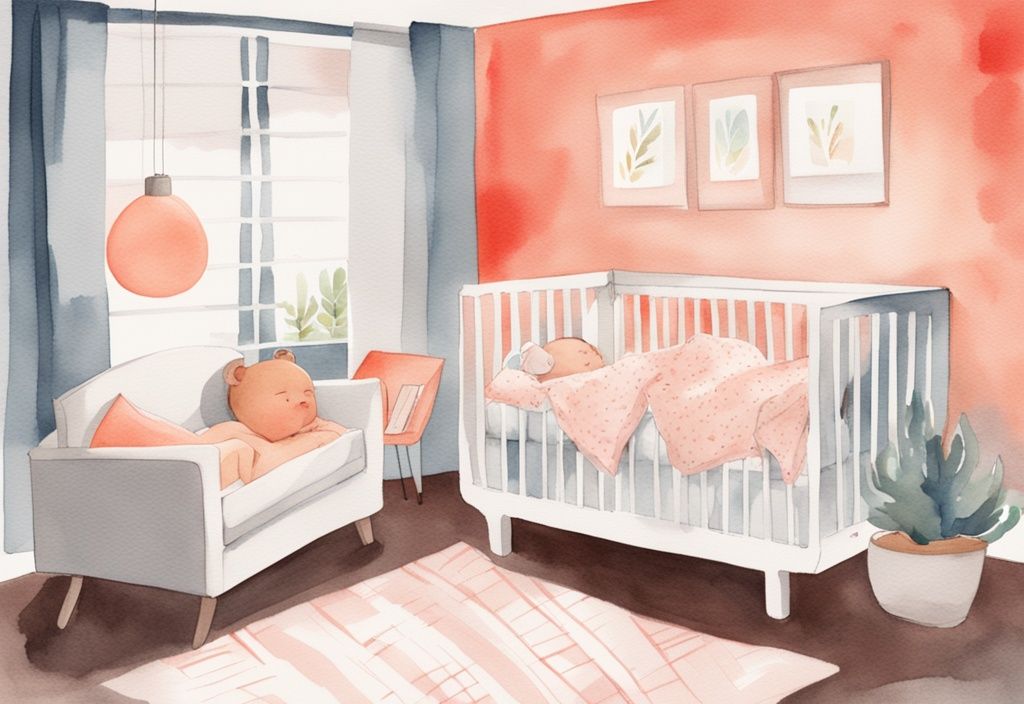Hey there, fellow sleep-deprived parent! Are you wondering how to navigate the confusing world of baby sleep training methods? You’re not alone. I’ve been there, and I’m here to help.
In this guide, we’ll explore various sleep training techniques, from the Cry-It-Out method to the No Tears approach. Each comes with its own set of benefits and challenges, and we’ll break them down so you can choose the one that suits your baby’s unique needs.
We’ll also delve into creating a soothing bedtime routine and overcoming common setbacks. So, let’s embark on this journey together, towards better sleep for both you and your little one.
What is Sleep Training and When to Start?
Sleep training is a journey many parents embark on to help their little ones—and themselves—get a good night’s rest. This section will explore what sleep training entails and how to determine the right time to start.
Defining Sleep Training
Ah, sleep training! It’s a set of strategies that aim to teach our little bundles of joy to self-soothe and fall asleep on their own. These sleep training methods for babys are crafted to help your baby snooze through the night without needing you to be their all-night DJ. The main goal? To boost sleep quality for both baby and parents by nurturing healthy sleep habits.
By weaving these techniques into your nightly routine, you’re creating a cozy environment where your baby can learn to navigate their sleep patterns. Imagine more restful nights for everyone—sounds dreamy, right?
Identifying the Right Time to Begin
Timing is everything, especially when it comes to sleep training. Experts usually suggest starting when your baby is between 4 to 6 months old. At this age, their sleep patterns start to resemble ours a bit more, making it the perfect time to introduce sleep training methods for babys.
But hey, every family is unique! Some might feel ready to dive in at four months, while others may prefer to wait until their baby is nine months old. The secret sauce? Tune into your baby’s development and your own comfort level. Remember, there’s no rush—just find what feels right for you and your little one.
Benefits of Sleep Training Your Baby
Hey there, fellow parents! Let’s dive into the world of sleep training methods for babys and explore how they can transform your nights. Imagine this: your little one snoozing peacefully through the night, and you finally getting those precious hours of uninterrupted sleep. Sounds dreamy, right? By teaching our babies to sleep independently, we can reduce those frequent nighttime wake-ups that leave us all feeling like zombies. Trust me, it’s a game changer!
Now, I know what you might be thinking—will this really work for my family? Well, let me share a little secret from my own experience. Once my kiddos started sleeping through the night, the whole household felt like it was running on a fresh burst of energy. It’s like hitting the reset button for everyone. Not only does it help with physical rest, but it also does wonders for our mental well-being. Less sleep-related stress means a happier, more harmonious home. And who doesn’t want that?
One of the best parts? Research shows that sleep training methods for babys are safe and don’t have any long-term negative effects on our little ones. Knowing this can give us the confidence to embrace sleep training without any guilt. It’s all about supporting our child’s development while nurturing a healthier family dynamic. So, let’s embark on this journey together, knowing we’re doing something wonderful for our babies and ourselves. You’re not alone in this, and I’m here cheering you on every step of the way!

Exploring Various Sleep Training Methods for Babies
When it comes to sleep training methods for babies, there are several approaches that parents can consider. Each method has its unique philosophy and techniques, offering different levels of involvement and comfort. Let’s dive into some of the most popular sleep training methods and see what might work best for you and your little one.
Understanding the Cry-It-Out (CIO) Method
The Cry-It-Out (CIO) Method is one of those approaches that can be quite the emotional rollercoaster. Essentially, you let your baby cry for a set period before offering comfort. The idea is to teach them how to self-soothe and fall asleep without needing you every time. It’s effective for some families, but let’s be real—hearing your baby cry isn’t easy. A consistent routine and a safe sleep environment are key to making this method work.
Decoding the Ferber Method
Ah, the Ferber Method, also known as graduated extinction. It’s like a middle-ground approach where you gradually increase the time you wait before comforting your baby. You check in at intervals, giving reassurance without picking them up. This method aims to help your little one learn to self-soothe, making it a popular choice for parents who want a balanced approach.
Unveiling the Chair Method
The Chair Method is a gentle, gradual technique where you sit in a chair near the crib and slowly move it further away each night. Your baby gets to feel your presence, which can be comforting, while they learn to fall asleep on their own. It’s a less stressful approach for both you and your baby, providing a sense of security during the transition.
Demystifying the Fading Method
With the Fading Method, you gradually reduce the time spent on soothing techniques like rocking or singing. It’s all about slowly stepping back and encouraging your baby to take the lead in falling asleep. This method is super flexible, allowing you to tailor it to your baby’s unique sleep patterns and temperament.
Exploring the Pick-Up/Put-Down Method
The Pick-Up/Put-Down Method involves picking up your baby to soothe them and then placing them back in the crib before they fall asleep in your arms. It’s a delicate dance of offering comfort while promoting independence. Patience and consistency are your best friends here, as you balance reassurance with encouraging self-soothing skills.
Learning about the No Tears Method
The “No Tears” Method is all about creating a consistent bedtime routine with minimal crying. You respond promptly to your baby’s needs, focusing on a secure and comforting sleep environment. It’s perfect for parents who prefer a nurturing approach, building a strong sense of security and trust between you and your little one.
Discovering the Sleep Lady Shuffle Method
The Sleep Lady Shuffle is a nurturing method where you stay with your baby until they fall asleep, gradually moving further away over time. You provide comfort and reassurance, helping your baby develop self-soothing skills. It’s a gentle, supportive approach for parents who want to encourage independent sleep without rushing the process.
Getting to Know the Check and Console Method
The Check and Console Method involves checking on and consoling your baby at set intervals, even before they start crying. This approach aims to prevent distress while promoting self-soothing. It’s a practical choice for parents who want to maintain a comforting presence while fostering their baby’s ability to sleep independently.
How to Choose the Right Sleep Training Method for Your Baby
Choosing the right sleep training method for your baby can feel like navigating a maze, but it’s all about finding what fits your family’s unique rhythm. Let’s explore how to make this journey smoother by considering your family’s needs, your baby’s temperament, and the flexibility of combining different approaches.
Considerations for Selecting a Method
When you’re diving into the world of sleep training methods for babies, it’s like picking the perfect recipe for a family dinner. You want something that suits everyone’s taste. Think about your family’s values and comfort levels—these are your guiding stars. And let’s not forget the little star of the show: your baby. Each baby has their own personality, and understanding this can help you choose a method that feels just right. Remember, there’s no one-size-fits-all solution, so trust your instincts and aim for a method that brings peace to both you and your baby.
Assessing Family Needs and Parenting Style
Finding the best sleep training methods for babies is like fitting a puzzle piece into your family’s daily life. Consider your routines, work schedules, and lifestyle. You want a method that slots in smoothly, allowing for consistency without causing extra stress. Reflect on how much time and emotional energy you can dedicate to this journey. Aligning the method with your family’s long-term sleep goals can lead to more restful nights and a happier home. It’s all about making life a little easier and a lot more joyful.

Understanding Your Baby’s Temperament
Your baby’s temperament is like their own little fingerprint, and it’s key to choosing effective sleep training methods for babies. Spend some time observing their sleep patterns, how they handle changes, and what kind of soothing techniques they respond to. Some babies might thrive with a structured routine, while others need a softer touch. By tailoring the method to your baby’s unique personality, you’re setting the stage for a smoother transition to independent sleep. It’s all about working with your baby’s natural rhythm.
Combining and Adapting Methods
Feel free to mix and match sleep training methods for babies—think of it as creating your own special blend. Flexibility is your best friend here, allowing you to tackle specific challenges or adapt to changes in your baby’s sleep patterns. By combining elements from different methods, you can craft a strategy that truly supports your baby’s progress. This adaptability ensures that your approach grows with your baby, leading to more successful sleep training outcomes. Remember, you’ve got this, and your baby is lucky to have you guiding them through this journey.
Proven Tips for Successful Sleep Training
Sleep training can feel like a daunting task, but with the right approach, it can be a rewarding experience for both you and your baby. In the following sections, we’ll explore some key sleep training methods for babys that have proven effective, focusing on consistency, soothing routines, wake windows, and creating the perfect sleep environment.
Importance of Consistency and Patience
Oh, the magic of consistency! It’s truly the backbone of any successful sleep training method for babys. By sticking to a steady routine, you’re helping your little one adjust to new sleep habits. It’s not always a smooth ride—there might be bumps along the way. But remember, patience is your best friend here. Keep a positive attitude and stay committed to your chosen method. This dedication not only boosts your chances of success but also creates a peaceful sleep environment for both you and your baby.
Developing a Soothing Bedtime Routine
Establishing a calming bedtime routine is like giving your baby a gentle nudge towards dreamland. Think of it as a series of cues that signal it’s time to wind down. A warm bath, a bit of gentle rocking, or a sweet bedtime story can work wonders. This routine helps your baby relax and understand the difference between day and night. It’s a cornerstone of successful sleep training methods for babys, ensuring they develop healthy sleep patterns.
Recognizing and Utilizing Wake Windows
Wake windows—what a game changer! These are those precious periods when your baby is naturally more alert and ready for sleep. By aligning naps and bedtime with these windows, you can avoid the dreaded overtiredness. This makes it so much easier for your baby to drift off. Properly managing these windows ensures your baby is just the right amount of tired, smoothing the path to sleep.
Creating a Sleep-Inducing Environment
Let’s talk about the sleep environment. It’s a biggie in effective sleep training methods for babys. A quiet, dark, and comfy space can really set the stage for restful sleep. Consider tools like blackout curtains, a white noise machine, or a cozy sleep sack to enhance the setting. And, of course, make sure the sleep area is safe and free from distractions. This creates a secure, comforting space where your baby can rest peacefully.
Overcoming Sleep Training Challenges and Setbacks
Every parent knows that sleep training methods for babies can be a rollercoaster ride. From unexpected illnesses to the dreaded teething phase, these hurdles might feel like a giant pause button on your progress. But fear not! With a sprinkle of patience and a dash of adaptability, you can steer through these bumps. Remember, these hiccups are just part of the parenting adventure, and with consistency, you’ll be back on track, helping your little one develop those all-important healthy sleep habits.
Addressing Common Sleep Training Issues
Let’s face it, sleep training methods for babies aren’t always smooth sailing. Life happens—your baby catches a cold, or suddenly, those tiny teeth start making an appearance. These challenges can throw a wrench in your plans. But here’s the good news: they’re manageable! Stay flexible and be ready to tweak your approach. Consistency is your best friend here. Just like any journey, there will be detours, but with understanding and patience, you’ll support your baby in finding their sleep groove.

Modifying Methods as Your Baby Grows
Babies grow faster than you can say “peekaboo,” and with that growth comes changing sleep needs. It’s like trying to hit a moving target! But don’t worry, being open to change is key. Regularly check in on your baby’s progress and be willing to adjust your sleep training methods. As your baby moves through different stages, staying in tune with their evolving needs will ensure your approach remains effective and nurturing. Remember, flexibility is your secret weapon!
When to Seek Professional Help
Sometimes, despite your best efforts, sleep training methods for babies might not hit the mark. If after a couple of weeks you’re still struggling, it might be time to call in the pros. A pediatrician or sleep consultant can offer fresh insights and tailor-made strategies to tackle those tricky sleep challenges. Trust your instincts—knowing when to seek help is a strength, not a weakness. Professional guidance can be a game-changer, leading to successful sleep training and a happier household for everyone involved.
FAQs on Sleep Training Methods for Babys
What is the Ideal Age to Start Sleep Training?
Many parents wonder when to begin this journey. Typically, the sweet spot is between 4 to 6 months. At this age, your little one’s sleep patterns are maturing, making it a bit easier to introduce sleep training methods for babys. Of course, every baby is unique, and some families might find that adjusting the timing based on their baby’s readiness works best.
Is Sleep Training Harmful to My Baby?
It’s a common worry, but rest assured, sleep training is generally safe and healthy when done at the right age and in a nurturing environment. Research shows that sleep training methods for babys don’t have any long-term negative effects. So, you can feel confident in your decision, knowing you’re supporting your baby’s development.
What to Do When Sleep Training Isn’t Working?
If you find yourself in a bit of a pickle with sleep training, don’t fret! Sometimes, it’s about reassessing the method you’ve chosen and making a few tweaks. Consulting with a pediatrician or a sleep consultant can offer valuable insights. Remember, patience and consistency are your best friends when implementing sleep training methods for babys.
How Long Does Sleep Training Typically Take?
This is a question many parents ask, and understandably so. The duration can vary depending on the method and how your baby responds. Some babies might adjust within a few days, while others could take a few weeks. Keep in mind, consistency and patience are key to successfully implementing sleep training methods for babys. You’re doing great, and your little one will get there!
Wrapping Up: Your Baby’s Sleep Training Journey
Every baby’s sleep training journey is a unique adventure, filled with little victories and milestones. As parents, it’s so important to celebrate each tiny step forward. This journey isn’t just about teaching your baby to sleep on their own; it’s also about understanding their needs and adapting along the way.
Trusting your parental instincts is essential in this process. While there are many sleep training methods for babies that offer structured approaches, remember that flexibility is your best friend. Tailoring these methods to fit your baby’s personality and your family’s lifestyle can lead to more successful outcomes. There’s no one-size-fits-all solution here, and being open to change can make the journey smoother.
Sleep training is a valuable tool that helps babies develop healthy sleep habits, which ultimately boosts the well-being of the entire family. By creating a nurturing sleep environment and sticking to a routine, you can help your baby learn to self-soothe and sleep independently. This not only improves your baby’s sleep quality but also positively impacts your mental health and family dynamics.


